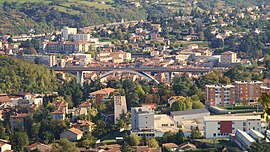Rive-de-Gier
| Rive-de-Gier | ||
|---|---|---|

View of Rive-de-Gier from the northwest
|
||
|
||
| Coordinates: 45°31′49″N 4°37′04″E / 45.5303°N 4.6178°ECoordinates: 45°31′49″N 4°37′04″E / 45.5303°N 4.6178°E | ||
| Country | France | |
| Region | Auvergne-Rhône-Alpes | |
| Department | Loire | |
| Arrondissement | Saint-Étienne | |
| Canton | Rive-de-Gier | |
| Intercommunality | Saint-Étienne Métropole | |
| Government | ||
| • Mayor (2008–2014) | Jean-Claude Charvin (PR) | |
| Area1 | 7.33 km2 (2.83 sq mi) | |
| Population (2008)2 | 14,831 | |
| • Density | 2,000/km2 (5,200/sq mi) | |
| Time zone | CET (UTC+1) | |
| • Summer (DST) | CEST (UTC+2) | |
| INSEE/Postal code | 42186 /42800 | |
| Elevation | 227–394 m (745–1,293 ft) (avg. 260 m or 850 ft) |
|
| Website | Site de la ville de Rive-de-Gier | |
|
1 French Land Register data, which excludes lakes, ponds, glaciers > 1 km² (0.386 sq mi or 247 acres) and river estuaries. 2Population without double counting: residents of multiple communes (e.g., students and military personnel) only counted once. |
||
1 French Land Register data, which excludes lakes, ponds, glaciers > 1 km² (0.386 sq mi or 247 acres) and river estuaries.
Rive-de-Gier is a commune in the Loire department in central France.
It was an important center of Loire coal mining basin, glass making and iron and steel manufacture in the 19th century. In the late 20th century the town lost most of its heavy industries.
Rive de Gier 24 km northeast of Saint Etienne, 39 km southwest of Lyon and 11 km from the town of Saint Chamond.
In the Celtic and Roman Gaul eras, the town lay on the boundary between the Segusiavi and the Allobroges.
The name of Rive-de-Gier is used for the first time in the 11th century. Renaud de Forez surrounded the town by walls and ditches during the reign of Philip II of France (1165-1223) . A hospital is mentioned in 1447. At the end of the 16th century the population was estimated at between 1,600 and 1,700 souls.
Between 1562 and 1864 there were clashes between Protestants and Catholics. King Henry IV of France (1553 - 1610) spent time at Rive-de-Gier. There was a castle and a Romanesque church, but both have been destroyed. During the uprising in Lyon against the National Convention in 1793, thirteen armed people of Lyon were killed by the inhabitants of Rive-de-Gier when they returned through the town after being defeated at Saint-Étienne.
In 1831 a riot of gunsmiths in Saint-Étienne injured several and led to the arrest of 18 people, The same year the miners of Rive-de-Gier, and then the glass makers, went on strike. The miners went on strike again in 1840 and 1844. In 1848 Jean-Marie Sigward, a glass maker, acclaimed the Republic.
Since the Gier is not navigable, a canal to Givors was opened in 1779 to transport coal. This canal, of which only a few remnants have survived, was replaced by the Saint-Étienne–Lyon railway, first passenger railway in France, built in 1828-33. Rive-de-Gier houses what was probably the first railway tunnel made in France.
...
Wikipedia



